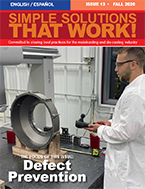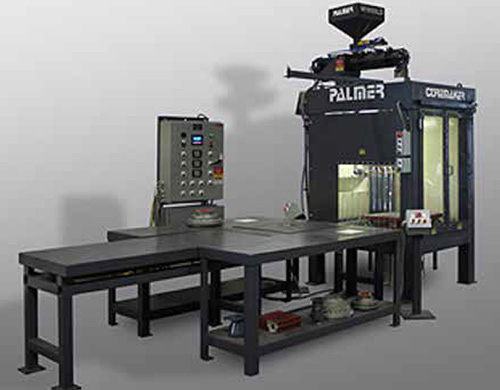Foundry & industrial processing Machinery EQUIPMENT & SYSTEMS
U.S. & Canada Call 1.800.457.5456
Moldmaking & Coremakinjg Automation Technologies Reduce Variability to Increase Quality
Home Articles Moldmaking & Coremakinjg Automation Technologies Reduce Variability to Increase Quality

Simple Solutions That Work!™, Volume 13, September 2020
Written - Jack Palmer
Jack Palmer
President
Palmer Manufacturing & Supply, Inc.
Article Takeaways:
A wise man once said, "With so many ways to make a bad casting, it's amazing we can ever make a good one."
While there are many areas for fingers to point once a casting runs into problems; the area we are going to address is the mixing and molding operation.
As lean manufacturing practitioners, we understand that anything the customer doesn't value is waste. Therefore, our entire goal is to produce mixing and molding equipment that eliminates waste in pursuit of delivering more high quality castings, at the lowest price, delivered when they are needed.
Automating systems to reduce human intervention to enhance quality control are not new to the foundry floor. Robotic cells, automatic pouring ladles, carousel molding systems, and transfer cars are all pretty common automation systems being deployed today.
MOLDING AUTOMATION
Automating the mixing and molding process with a carousel and a rollover has been the industry standard, until recently. The Universal Molding Machine (UMM) is a revolutionary molding system that takes the place of a traditional compaction table, carousel and rollover. Having fewer components in the process reduces variability, making it easier to achieve casting quality goals.
In this new automated system, the patterns are bolted to adjustable tooling frames that are easily changed out on the machine. The tooling frame accepts molds on top and bottom to accommodate match plates and can accept multiple boxes at a time when running smaller castings depending on the machine size selected. The base machine runs two tooling frames at a time for a minimum of four different patterns and two different molds.
As any foundryman will tell you, molding process consistency will make it easier to achieve casting quality while getting the sand out of the box quickly will drive casting productivity.
Casting quality and consistency will dramatically improve since many of the difficult to control variables are removed from the molding process. The elimination of these defects reduces rework and scrap rates, and cleaning room time.
GREEN SAND TO NO-BAKE COVERSION
Additionally, this technology is uniquely designed for green sand or no-bake tooling. Green sand molding has always required operators capable of being part scientist and part artist, with an attention to detail and experience requiring significant tribal knowledge involved in the individual foundry process. As the modern workforce continues to evolve, it becomes increasing difficult for foundries to find and retain qualified green sand molders with these attributes. Employees that can produce a consistently high quality, defect free end product in the green sand process are in extremely short supply.
When converting from a green sand molding system to the UMM process, the foundry will benefit from the elimination of the need for this operator expertise, as well as many of the daily casting defects and issues commonly associated with green sand molding.
This system reduces how many times a mold is touched by human hands, which reduces the chances to create defects. Maybe your operation doesn't need over 500 molds a day to meet your production needs, but this system will allow the foundry to get the molding done in a fraction of the day and then make your employees available to manage another process for the remainder of the day.

RFID IN THE COREROOM
Adjusting settings, recalling recipes, and documentation of recipe changes all require costly human intervention. And, when not performed correctly, result in costly human errors. RFID (radio frequency identification tags) represent a major break-through in foundry production, to reduce time for recipe management, the prevention of costly errors and enhance quality control. Unlike other key manufacturing breakthroughs, RFID can be deployed on specific equipment for a particular process or can be deployed plant-wide. Users have the ability to expand automation a little at a time, making this ideal for both small and large foundries.
While RFID technologies can be deployed on the molding line, perhaps one of the easiest places to introduce a foundry to RFID is in the core room. The process is not difficult, as a tag is simply fastened to the bottom of each core box. The tags (compliant with ISO 18000-3, ISO 15693, and ISO 14443 standards) each have a unique identification number that is read when the box is presented to the CoreMaker. During the set-up procedure, the worker enters the settings for that particular core box into the machine's programmable logic controller (PLC). Once the setting is determined, the worker saves it permanently to that recipe.
This equipment allows foundries to compete with lower prices from offshore foundries because it can truly guarantee quality. The quality control is built into the machine with the RFID tags and therefore, reduces human handling.
RFID technology runs on core machines with and without tooling mounted directly to the machine and removed after blowing and gassing.
To begin coremaking, the RFID interrogator built into the coremaker bench, reads the tag's number, and transmits that information to the PLC. Then, the computer retrieves the settings for that core. The worker presses one more button to begin the coremaking process, and the core box is moved into the core blower. The computer instructs the blower accordingly and injects sand and chemicals before purging the box.
The ability to make higher quality cores is the biggest advantage of RFID. Anytime you allow a worker to manually change recipes, your core's condition can be expected to change. Excessive amine catalyst material can weaken a core after metal is poured. RFID ensures that the core is guaranteed to be made with the proper settings. Higher quality cores mean higher quality parts.
The foundry floor is undergoing a transformation like never before with continuous improvement being the name of the game to produce better castings, in less time—guaranteed.
Some of the excepts in the article first appeared in Cast Metal & Diecasting Times.
Copyright © 2025 Palmer Manufacturing & Supply, Inc. | Terms and Conditions | Privacy Policy




